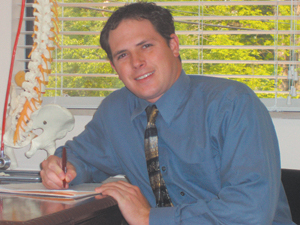A HEALTHY DAY
 Carpal Tunnel Syndrome
Carpal Tunnel Syndrome
Hand pain is one of the most disabling injuries that a person will ever notice. When most people experience pain in their hands, fingers, or forearms they automatically think they have carpal tunnel syndrome. The problem lies in the fact that people do not know exactly what carpal tunnel syndrome is. In this article I am going to inform you exactly what it is, where it affects you, how to prevent it, and what you can do to cure it.
Carpal tunnel syndrome occurs when a nerve in your hand (median nerve) gets impinged, or compressed under a ligament in your hand (transverse ligament of the wrist), which causes either a decrease in sensation, numbness, or pain in your hand. When you experience this, you feel the symptoms in half the ring finger and over to the thumb, excluding the tips of your fingers. A part of your median nerve splits off from the main median nerve and you get two different innervations. The main part of the median nerve (the one in your hand) goes through the carpal tunnel and innervates the ring finger and over to the pointer finger but below the tips of your fingers. Before the carpal tunnel at the wrist, a part of the nerve splits off, thus creating a sensation at the tips of the fingers but still within the ring finger over to the thumb.
The Pronator Teres is a muscle that attaches at the middle part of your elbow and connects to the outer forearm. This is the main muscle that helps you turn your wrist and arm towards your body. The median nerve travels underneath this muscle and can get compressed. When this happens, you get a decrease in sensation in your whole hand disregarding your ring finger and over to the pinky.
Carpal tunnel and pronator teres syndrome is a risk for people who perform many intricate actions with their hands. Ranging from toolmakers, upholsterers, seamstresses, guitar players, secretaries, bakers (rolling dough) and pretty much anyone who does a-lot of turning, twisting, and typing motions with their hands. You can also get carpal tunnel syndrome from over-activity of the pituitary gland, hypothyroidism, diabetes, and inflammatory arthritis.
There are many chiropractic and physical therapy treatments that can conservatively treat Carpal tunnel syndrome, as well as pronator teres syndrome by applying Anodyne Therapy to the tight muscles, ligaments, and tendons. Secondly, stretching the ligaments, tendons, and muscles involved will reduce the pain. Thirdly, chiropractic adjustments to the carpal tunnel, forearm, and elbow will help. Lastly, strengthening exercises to the antagonist muscles to prevent further injury. You can also do things to prevent carpal tunnel syndrome by doing stretches and light exercises to the muscles involved, taking frequent breaks at work, wearing splints to keep the wrist straight, and educate yourself with the proper ergonomics for the best possible way for the worker to perform their job. This is best for those who experience this from a mechanical condition but not for someone that has an internal cause of carpal tunnel syndrome, i.e. diabetes, thyroid problems, pregnancy, or other causes either known or unknown. Just remember what to look for and also know that, for now, the symptoms can be treated but the cause will still need to be cured. Also, let it be known that conservative treatment does not work for all people and if you do not get any relief with at least 3 conservative treatments then surgery should be considered.
If you have any questions, please feel free to contact me Dr. James Nill D.C., at Nill Family Chiropractic & Wellness Center, 4656 W. Jefferson Blvd., Suite 240 Fort Wayne, IN 46804. 260-459-2205 or e-mail at drnill@nillfamilychiropractic.com.
- Celebrating 20 Years Of Community At The Stand - April 12, 2024
- First Positive Case Of Chronic Wasting Disease In Indiana - April 12, 2024
- Southwest Allen County Schools Embark On Major Tree Plantings - April 12, 2024


